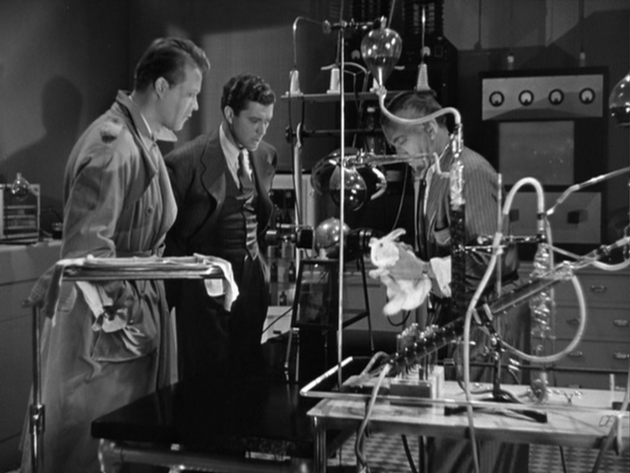The Return Of Doctor X is a movie with very little value to it aside from the anomaly of being Humphrey Bogart’s only horror/science fiction film in which he plays the titular Dr Maurice Xavier, a.k.a. Marshall Quesne (pronounced “caine”). Dr. Xavier is essentially a zombie-vampire, a doctor who was sentenced to the electric chair after trying to see how long babies could go without eating (gruesome even for today, let alone 1939), only to be resurrected by a proto Dr Frankenstein, Dr Francis Flegg (John Litel) and is kept alive by regular injections of Type One blood. I do love the Karloff-like design of the character with his pale, white face, punk rock style hair with the white streak and a rabbit which he carries around with him (I’m making this my future Halloween costume). The Return Of Doctor X is a rare instance in which Bogart played a subservient character, of whom is quite Peter Lorre-esque with his tragic and pathetic demeanour, while his unnatural body movements and limping call back to Karloff’s Frankenstein’s Monster. The film’s climax does, however, venture into more traditional Bogart territory in which Xavier partakes in a gangster-style shootout. Bogart is a consummate professional who doesn’t phone in the role regardless of how much he was known to detest it. Just contrast him to his master played by John Litel, of whom the movie gives him somewhat of an arc in which he eventually regrets his actions playing God, he is a much more generic bad guy.

According to the audio commentary for The Return Of Doctor X featuring director Vincent Sherman (of whom went on to do better work in his career), the film had a troubled production with the original script going in one direction and then being significantly altered during filming. This is evident when watching the film’s trailer of which the majority of footage featured is not in the finished picture not to mention the film’s as various credit errors (Wayne Morris is billed as Walter Barnett but is referred to as Walter Garrett in the film). Likewise, the film oddly gives the “All persons fictitious” disclaimer full-screen treatment before the opening titles, whereas it’s usually in small print at the bottoms of the credits. What was the studio worried about?

The premise of The Return Of Doctor X has potential with its mix of vampirism and reincarnation but with the exception of Bogart, the mystery yarn fails to flesh out the story or characters (although I do find it interesting that the movie has to explain the more recent scientific discovery of blood group types, whereas today this is common, layman knowledge). Wayne Morris might have worked at the title character in Kid Galahad but he’s no leading man material in the role of a go-getter reporter from Wichita. The Return Of Doctor X is a typical example of the Warner Bros B-movie product of the late 30’s/early 40’s – the film is by the numbers and has no real flashy moments. Worst of all, it is masquerading as a sequel to the two-tier Technicolor, pre-code gem Doctor X, however, there is no connection between the two films. Many would point to The Return Of Doctor X as an embarrassment in the career of Humphrey Bogart, however I would point to it as another example of how great an actor he is as he brings so much life to an otherwise average film when he’s on-screen. Boris Karloff made a career playing roles like this, why should Bogart’s attempt at playing a monster be looked down upon?

